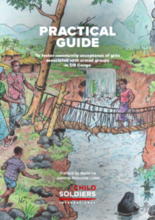Introduction
Context
Guided by previous research by Child Soldiers International, recommendations to the DRC made by the Committee on the Rights of the Child, and consultations with Congolese NGOs, Child Soldiers International developed a project to assess the effectiveness of release, psychosocial recovery and reintegration programmes (DDR) for girls under the age of 18 associated with armed groups in eastern DRC.
As part of this project, a research team spent six weeks in South Kivu, North Kivu and Haut-Uélé in early 2016, and interviewed 150 girls formerly associated with armed groups, as well as 84 members of community-based child protection networks (known as “RECOPE” in French), 12 teachers and school principals, 8 religious leaders, 46 DDR actors and 14 local authority officials. The study sought to shed some light on the extent to which girls benefit from DDR programmes, and on the appropriateness of the support where it was received – primarily from the point of view of the girls themselves.
The research confirmed what previous studies had already revealed; that girls are underrepresented in the total number of children demobilised from armed groups, that they have not had access to DDR services to the same extent as boys, and that in cases where they have received assistance, it has not been sufficiently adapted to their specific needs and circumstances. In particular, the research showed that, despite encouraging exceptions, girls are often discriminated against and stigmatised upon returning to their communities, and that DDR programs do not adequately address this fundamental issue of family and community acceptance.
In October 2016, Child Soldiers International presented its findings at a workshop in Goma which brought together DDR actors, UN agencies, NGOs and government representatives. The workshop participants listened to the hardships and recommendations of the girls, as reported by Child Soldiers International, and then discussed solutions and proposed interventions to meet the girls’ needs, facilitate their release and reintegration while respecting their rights.
Objectives
This guide is a collection of practical ideas and experiences from the participants in the Goma workshop. It is presented as a “toolbox” to help DDR actors respond to the needs of girls formerly associated with armed groups in eastern DRC, and to overcome the many obstacles to their release and reintegration, reported by some of the girls themselves. Many of the interventions proposed in this guide are not new and have already been used by some NGOs. However, they are not necessarily known or systematically used by all DDR actors.
The child protection actors interviewed by the research team highlighted the fact that funding for child DDR had ceased (in some areas over two years ago, and in others more recently) or that it had become so restricted that they could only reach a very small number of children associated with armed groups in their area. For this reason, with the exception of education, this guide focuses on interventions that are inexpensive and can be carried out by community members - building on existing community resources. In some cases, initial support (technical or material) is required; this could come from the Executive Unit in charge of the national DDR programme (UEPN-DDR), the provincial divisions of the Ministry of women, family and children’s affairs (DIVIFFAE), the provincial divisions of the Ministry of Social Affairs (DIVAS), or another DDR provider.
To read "What the girls say," a report of the research findings from the study of former girl soldiers in DRC, please click here.

